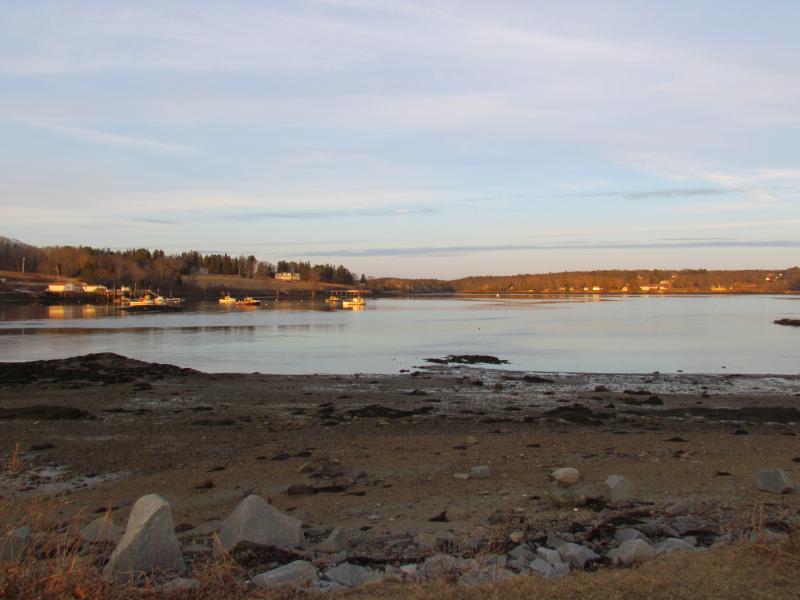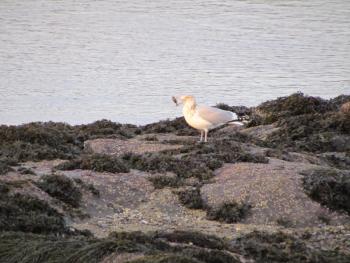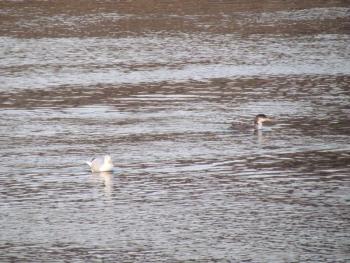It was a gorgeous post-Christmas winter day along the coast of Maine. The air was in the crisp but not terribly cold 20s. The sun was shining; the air and sea were calm. All was still as we gazed out over the lobster boats in Pemaquid Harbor; the only sounds were the soft lapping of water, the muffled grunting of the eiders across the bay, and the occasional cry of a gull.
Despite the serenity of the scene, a lot of interesting things were going on in front of us.
The common eiders—the males in their black-and-white tuxedo suits and the females in their warm brown—were actively diving for shellfish, crabs, and other food.
Scattered among them were pirates.
Not the human type, they were “pirate” herring gulls, waiting and watching to see where an eider would pop up to the surface and whether or not it had a food item in its bill it could steal. One or more gulls would leap off the water and try to drop down on top of the eider to snatch the food before the eider could swallow it or dart away with it. If the gull was successful in stealing away the prey item, another gull would invariably chase after the first pirate to try and steal it themselves.
We remembered years ago watching ring-billed gulls out in Upstate New York at Myer’s Point near Ithaca, stealing crayfish from hooded mergansers in a similar fashion. It was interesting to note that in both cases it was not only adult gulls (large gulls take up to four years to reach breeding plumage) who had learned this pirate behavior but even some younger birds.
Closer in front of us along the shore, we began noticing that there were another set of gulls engaged in a completely different strategy for finding their sustenance. Two or three adult herring gulls were pulling what looked like mussels off a small rocky islet exposed by the receding tide. Holding the mussel in their bill, they would circle around in front of us and, hovering for a second, drop the mussel. Of course, this is classic herring gull behavior that many of us have watched and admired throughout our lives. But it is still quite remarkable that they have learned this methodology and that it is passed on from generation to generation. It was really fascinating to see how one bird repeatedly tried dropping a shell on the pebbly beach-mudflat without success before it gave up and began dropping it on a ledge that was favored by another clever bird. Before dropping the item onto the mudflat, the bird flew up about 50 feet and let the mussel go; over the hard ledge, it only ascended about 5 or 10 feet before releasing it. Fascinating!
Apparently, there are only a few dozen birds out of the thousands of species around the world that have learned this behavior. The list includes a number of gull species such as our own great black-backed and ring-billed gulls (although we couldn’t remember whether we ourselves had ever seen either of these species dropping prey to break open the shells) as well as a number of crow species and some raptors. Bald and golden eagles have even been observed dropping turtles on hard surfaces to try to break open the shells.
While all this was going on, a wintering common loon, in its muted gray-brown plumage, glided in close to shore. We may think of loons as strictly fish eaters but not so this or some of the other loons we watched in the harbor that day. They were finding crabs, shaking them vigorously and swallowing them down. At one point one of those pirate gulls noticed and tried to dive in for the steal but the loon just dove down with the prey and came up farther away, swallowing the food before the pirate could try again.
It may have been quiet at the harbor, but there was an amazing pageant of avian activity happening in front of us. It was a delightful natural gift to our senses. We hope all of you will be able to enjoy a similar gift this holiday season!
Jeffrey V. Wells, Ph.D., is a Fellow of the Cornell Lab of Ornithology. Dr. Wells is one of the nation's leading bird experts and conservation biologists and author of the “Birder’s Conservation Handbook.” His grandfather, the late John Chase, was a columnist for the Boothbay Register for many years. Allison Childs Wells, formerly of the Cornell Lab of Ornithology, is a senior director at the Natural Resources Council of Maine, a nonprofit membership organization working statewide to protect the nature of Maine. Both are widely published natural history writers and are the authors of the popular book, “Maine’s Favorite Birds” (Tilbury House) and “Birds of Aruba, Bonaire, and Curaçao: A Site and Field Guide,” (Cornell University Press).
































